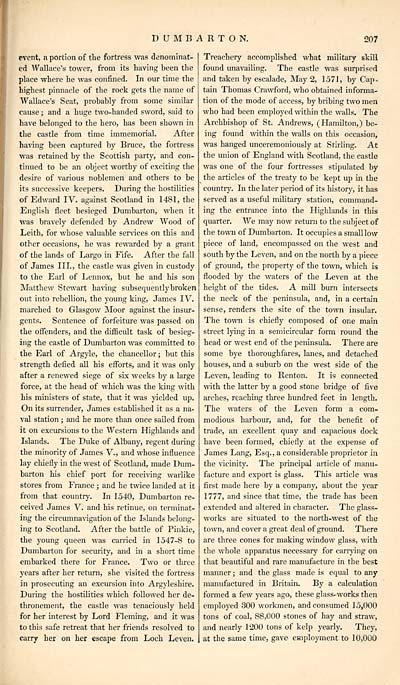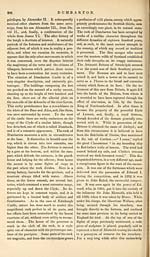Gazetteer of Scotland > Volume 1
(235) Page 207
Download files
Complete book:
Individual page:
Thumbnail gallery: Grid view | List view

DUMBARTON.
207
event, a portion of the fortress was denominat-
ed Wallace's tower, from its having been the
place where he was confined. In our time the
highest pinnacle of the rock gets the name of
Wallace's Seat, probably from some similar
cause ; and a huge two-handed sword, said to
have belonged to the hero, has been shown in
the castle from time immemorial. After
having been captured by Bruce, the fortress
was retained by the Scottish party, and con-
tinued to be an object worthy of exciting the
desire of various noblemen and others to be
its successive keepers. During the hostilities
of Edward IV. against Scotland in 1481, the
English fleet besieged Dumbarton, when it
was bravely defended by Andrew Wood of
Leith, for whose valuable services on this and
other occasions, he was rewarded by a grant
of the lands of Largo in Fife. After the fall
of James III., the castle was given in custody
to the Earl of Lennox, but he and his son
Matthew Stewart having subsequentlybroken
out into rebellion, the young king, James IV.
marched to Glasgow Moor against the insur-
gents. Sentence of forfeiture was passed on
the offenders, and the difficult task of besieg-
ing the castle of Dumbarton was committed to
the Earl of Argyle, the chancellor ; but this
strength defied all his efforts, and it was only
after a renewed siege of six weeks by a large
force, at the head of which was the king with
his ministers of state, that it was yielded up.
On its surrender, James established it as a na-
val station ; and he more than once sailed from
it on excursions to the Western Highlands and
Islands. The Duke of Albany, regent during
the minority of James V., and whose influence
lay chiefly in the west of Scotland, made Dum-
barton his chief port for receiving warlike
stores from France ; and he twice landed at it
from that country. In 1540, Dumbarton re-
ceived James V. and his retinue, on terminat-
ing the circumnavigation of the Islands belong-
ing to Scotland. After the battle of Pinkie,
the young queen was carried in 1547-S to
Dumbarton for security, and in a short time
embarked there for France. Two or three
years after her return, she visited the fortress
in prosecuting an excursion into Argyleshire.
During the hostilities which followed her de-
thronement, the castle was tenaciously held
for her interest by Lord Fleming, and it was
to this safe retreat that her friends resolved to
cany her on her escape from Loch Leven.
Treachery accomplished what military skill
found unavailing. The castle was surprised
and taken by escalade, May 2, 1571, by Cap-
tain Thomas Crawford, who obtained informa-
tion of the mode of access, by bribing two men
who had been employed within the walls. The
Archbishop of St. Andrews, (Hamilton,) be-
ing found within the walls on this occasion,
was hanged unceremoniously at Stirling. At
the union of England with Scotland, the castle
was one of the four fortresses stipulated by
the articles of the treaty to be kept up in the
country. In the later period of its history, it has
served as a useful military station, command-
ing the entrance into the Highlands in this
quarter. We may now return to the subject of
the town of Dumbarton. It occupies a small low
piece of land, encompassed on the west and
south by the Leven, and on the north by a piece
of ground, the property of the town, which is
flooded by the waters of the Leven at the
height of the tides. A mill burn intersects
the neck of the peninsula, and, in a certain
sense, renders the site of the town insular.
The town is chiefly composed of one main
street lying in a semicircular form round the
head or west end of the peninsula. There are
some bye thoroughfares, lanes, and detached
houses, and a suburb on the west side of the
Leven, leading to Renton. It is connected
with the latter by a good stone bridge of five
arches, reaching three hundred feet in length.
The waters of the Leven form a com-
modious harbour, and, for the benefit of
trade, an excellent quay and capacious dock
have been formed, chiefly at the expense of
James Lang, Esq., a considerable proprietor in
the vicinity. The principal article of manu-
facture and export is glass. This article was
first made here by a company, about the year
1777, and since that time, the trade has been
extended and altered in character. The glass-
works are situated to the north-west of the
town, and cover a great deal of ground. There
are three cones for making window glass, with
the whole apparatus necessary for carrying on
that beautiful and rare manufacture in the best
manner ; and the glass made is equal to any
manufactured in Britain. By a calculation
formed a few years ago, these glass-works then
employed 300 workmen, and consumed 15,000
tons of coal, 88,000 stones of hay and straw,
and nearly 1200 tons of kelp yearly. They,
at the same time, gave employment to 10,000
207
event, a portion of the fortress was denominat-
ed Wallace's tower, from its having been the
place where he was confined. In our time the
highest pinnacle of the rock gets the name of
Wallace's Seat, probably from some similar
cause ; and a huge two-handed sword, said to
have belonged to the hero, has been shown in
the castle from time immemorial. After
having been captured by Bruce, the fortress
was retained by the Scottish party, and con-
tinued to be an object worthy of exciting the
desire of various noblemen and others to be
its successive keepers. During the hostilities
of Edward IV. against Scotland in 1481, the
English fleet besieged Dumbarton, when it
was bravely defended by Andrew Wood of
Leith, for whose valuable services on this and
other occasions, he was rewarded by a grant
of the lands of Largo in Fife. After the fall
of James III., the castle was given in custody
to the Earl of Lennox, but he and his son
Matthew Stewart having subsequentlybroken
out into rebellion, the young king, James IV.
marched to Glasgow Moor against the insur-
gents. Sentence of forfeiture was passed on
the offenders, and the difficult task of besieg-
ing the castle of Dumbarton was committed to
the Earl of Argyle, the chancellor ; but this
strength defied all his efforts, and it was only
after a renewed siege of six weeks by a large
force, at the head of which was the king with
his ministers of state, that it was yielded up.
On its surrender, James established it as a na-
val station ; and he more than once sailed from
it on excursions to the Western Highlands and
Islands. The Duke of Albany, regent during
the minority of James V., and whose influence
lay chiefly in the west of Scotland, made Dum-
barton his chief port for receiving warlike
stores from France ; and he twice landed at it
from that country. In 1540, Dumbarton re-
ceived James V. and his retinue, on terminat-
ing the circumnavigation of the Islands belong-
ing to Scotland. After the battle of Pinkie,
the young queen was carried in 1547-S to
Dumbarton for security, and in a short time
embarked there for France. Two or three
years after her return, she visited the fortress
in prosecuting an excursion into Argyleshire.
During the hostilities which followed her de-
thronement, the castle was tenaciously held
for her interest by Lord Fleming, and it was
to this safe retreat that her friends resolved to
cany her on her escape from Loch Leven.
Treachery accomplished what military skill
found unavailing. The castle was surprised
and taken by escalade, May 2, 1571, by Cap-
tain Thomas Crawford, who obtained informa-
tion of the mode of access, by bribing two men
who had been employed within the walls. The
Archbishop of St. Andrews, (Hamilton,) be-
ing found within the walls on this occasion,
was hanged unceremoniously at Stirling. At
the union of England with Scotland, the castle
was one of the four fortresses stipulated by
the articles of the treaty to be kept up in the
country. In the later period of its history, it has
served as a useful military station, command-
ing the entrance into the Highlands in this
quarter. We may now return to the subject of
the town of Dumbarton. It occupies a small low
piece of land, encompassed on the west and
south by the Leven, and on the north by a piece
of ground, the property of the town, which is
flooded by the waters of the Leven at the
height of the tides. A mill burn intersects
the neck of the peninsula, and, in a certain
sense, renders the site of the town insular.
The town is chiefly composed of one main
street lying in a semicircular form round the
head or west end of the peninsula. There are
some bye thoroughfares, lanes, and detached
houses, and a suburb on the west side of the
Leven, leading to Renton. It is connected
with the latter by a good stone bridge of five
arches, reaching three hundred feet in length.
The waters of the Leven form a com-
modious harbour, and, for the benefit of
trade, an excellent quay and capacious dock
have been formed, chiefly at the expense of
James Lang, Esq., a considerable proprietor in
the vicinity. The principal article of manu-
facture and export is glass. This article was
first made here by a company, about the year
1777, and since that time, the trade has been
extended and altered in character. The glass-
works are situated to the north-west of the
town, and cover a great deal of ground. There
are three cones for making window glass, with
the whole apparatus necessary for carrying on
that beautiful and rare manufacture in the best
manner ; and the glass made is equal to any
manufactured in Britain. By a calculation
formed a few years ago, these glass-works then
employed 300 workmen, and consumed 15,000
tons of coal, 88,000 stones of hay and straw,
and nearly 1200 tons of kelp yearly. They,
at the same time, gave employment to 10,000
Set display mode to: Large image | Transcription
Images and transcriptions on this page, including medium image downloads, may be used under the Creative Commons Attribution 4.0 International Licence unless otherwise stated. ![]()
| Gazetteers of Scotland, 1803-1901 > Gazetteer of Scotland > Volume 1 > (235) Page 207 |
|---|
| Permanent URL | https://digital.nls.uk/97427182 |
|---|
| Description | Volume I: Abbey to Glenartney. |
|---|---|
| Attribution and copyright: |
|
| Description | By Robert Chambers and William Chambers. Glasgow: Blackie & Son, 1838. 2 volumes. |
|---|---|
| Shelfmark | NF.1461.g.7 |
| Additional NLS resources: | |

